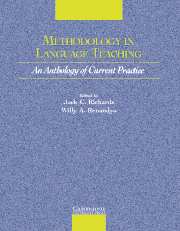Book contents
- Frontmatter
- Contents
- Acknowledgments
- Introduction
- Section I Approaches to Teaching
- Section 2 Lesson Planning and Classroom Management
- Section 3 Classroom Dynamics
- Section 4 Syllabus Design and Instructional Materials
- Section 5 Task and Project Work
- Section 6 Learning Strategies
- Section 7 Teaching Grammar
- Section 8 Teaching Pronunciation
- Section 9 Teaching Speaking
- Section 10 Teaching Listening
- Section 11 Teaching Vocabulary
- Section 12 Teaching Reading
- Section 13 Teaching Writing
- Section 14 Assessment
- Section 15 Technologies in the Classroom
- Section 16 Professional Development
- Credits
- Author Index
- Subject Index
Section 3 - Classroom Dynamics
Published online by Cambridge University Press: 10 November 2010
- Frontmatter
- Contents
- Acknowledgments
- Introduction
- Section I Approaches to Teaching
- Section 2 Lesson Planning and Classroom Management
- Section 3 Classroom Dynamics
- Section 4 Syllabus Design and Instructional Materials
- Section 5 Task and Project Work
- Section 6 Learning Strategies
- Section 7 Teaching Grammar
- Section 8 Teaching Pronunciation
- Section 9 Teaching Speaking
- Section 10 Teaching Listening
- Section 11 Teaching Vocabulary
- Section 12 Teaching Reading
- Section 13 Teaching Writing
- Section 14 Assessment
- Section 15 Technologies in the Classroom
- Section 16 Professional Development
- Credits
- Author Index
- Subject Index
Summary
INTRODUCTION
Most teachers would hope for a small class size in which students are more or less homogeneous in terms of proficiency. Except for a lucky few, however, most teachers find themselves working with a class of fifty students or more, and, to make matters worse, these students often exhibit a wide variety of abilities. This less than ideal situation often leads to the use of teaching methodology which does not promote optimal learning. For example, teacher-centered methodology, which largely ignores individual differences and the contribution of the learners in the learning process is, unfortunately, still ubiquitous in many ESL classrooms. Walk into a typical ESL classroom and you will observe a familiar situation where interaction in the classroom is dominated by the teacher, with the students mainly responding to the teacher's initiatives. Another familiar characteristic is one in which every student in class is doing more or less “the same thing, at the same time, and in the same way” (Ur, 1996, p. 233). The two papers in this section explore ways of making students become more active contributors in the learning process and examine principles for the design of learning activities and materials which allow for some degree of individualization in the classroom.
The first paper, by Jacobs and Hall, looks at the techniques and principles for implementing cooperative learning. When carefully planned and executed, cooperative learning can lead to a more dynamic classroom interaction that promotes more learning.
- Type
- Chapter
- Information
- Methodology in Language TeachingAn Anthology of Current Practice, pp. 49 - 51Publisher: Cambridge University PressPrint publication year: 2002
- 1
- Cited by

